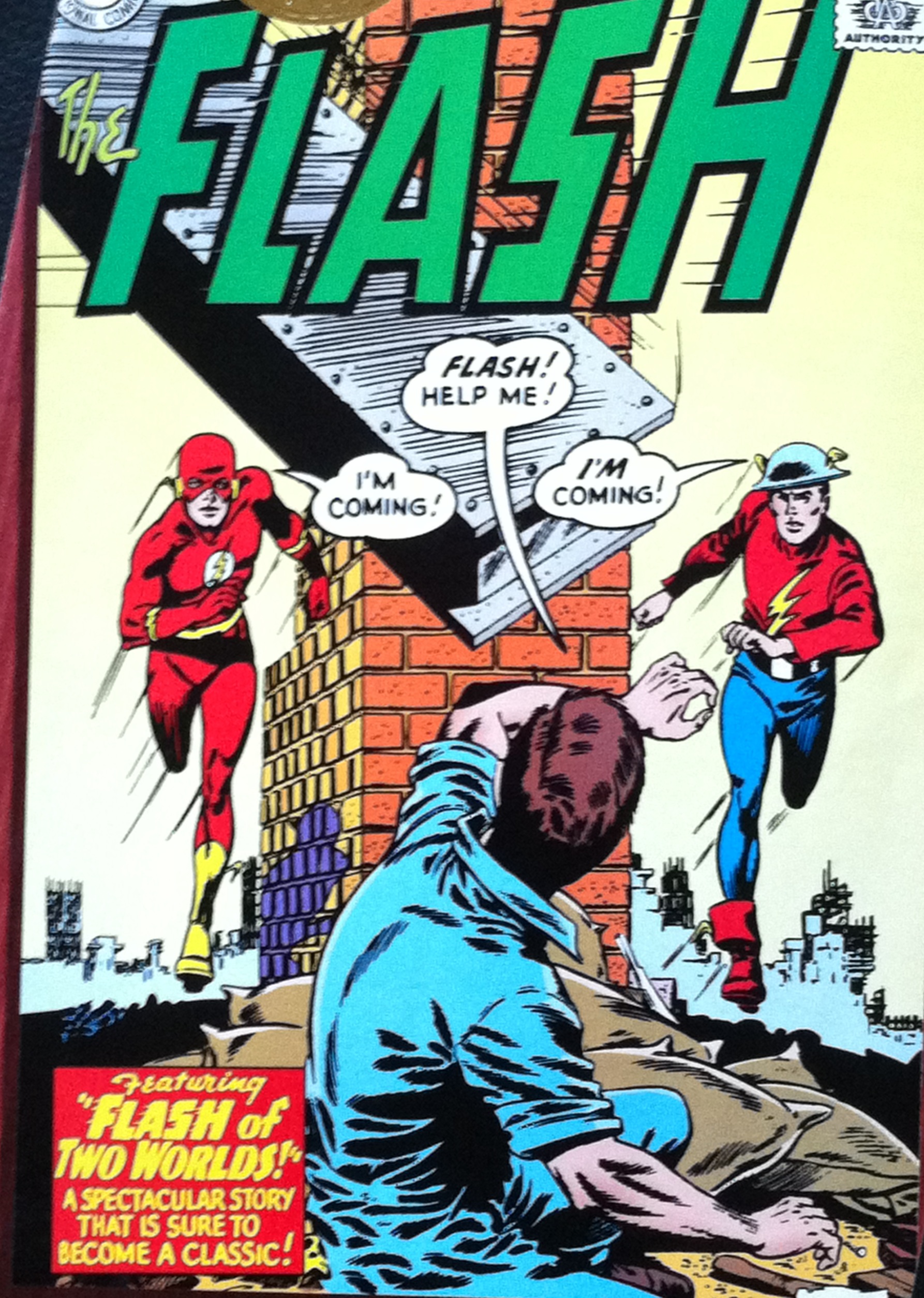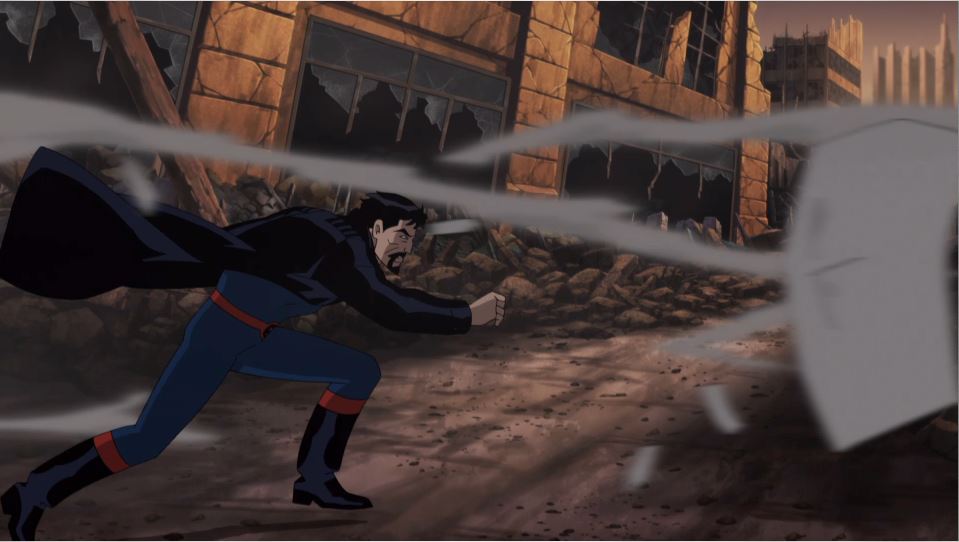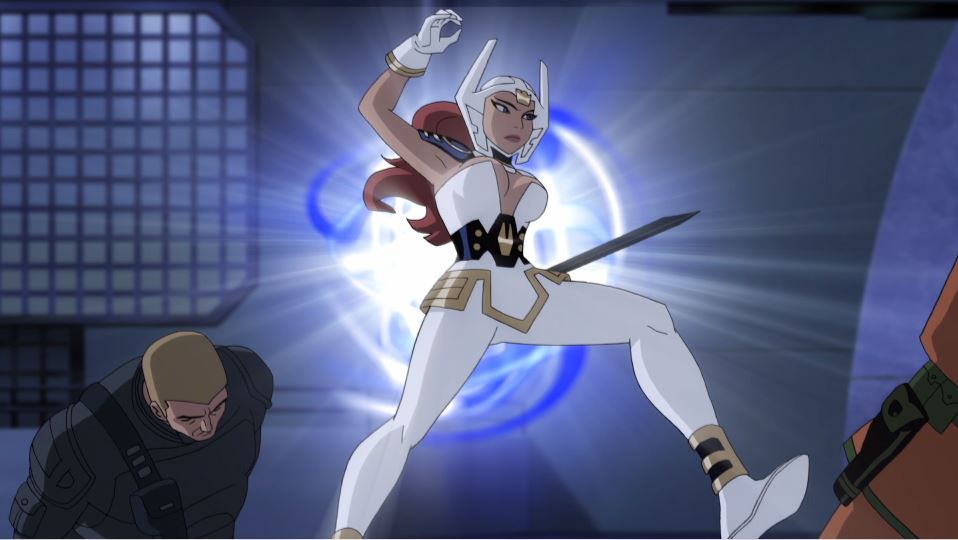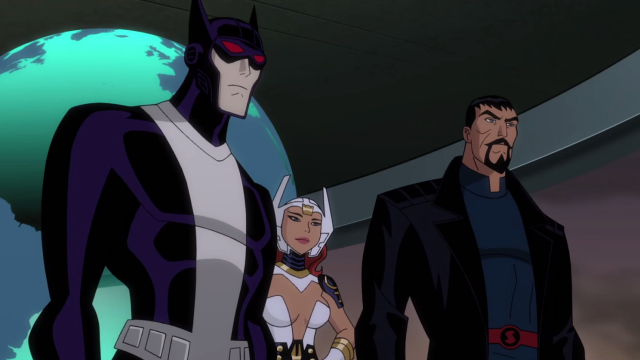Always thought Harley Quinn was disturbing because of her twisted love affair with the Joker? Here’s a version of the supervillain that’s even more unhinged. And the Batman who takes her down in this alternate universe does something… harsh.
Superman isn’t Clark Kent in this version of the Justice League. Wonder Woman isn’t from a place that worships Greek Gods. The Batman in Justice League: Gods & Monsters Chronicles short above is an actual vampire, one who does what most fictional bloodsuckers do. Best protect ya necks, bad guys.
Premiering today on Machinima, Justice League: Gods & Monsters Chronicles is a series of shorts directed by Bruce Timm — one of the men who gave us some of the best animated versions of DC Comics’ superheroes in the Batman, Superman and Justice League cartoons. Chronicles is a prologue to a full-length Justice League: Gods & Monsters movie coming in July, going in a completely different direction for Timm’s previous interpretation of the World’s Greatest Superheroes. They do the right thing — just barely — and do it in ways that are more ruthless than their better-known counterparts.
I spoke with Timm last week about Gods & Monsters and asked him why he decided to use different characters in these well-known heroic identities. Along with giving an answer to that question, he also talked about why it’s ok that superheroes kill sometimes. So, yeah, he was ok with Man of Steel‘s controversial ending.
Kotaku: We’ve been seeing evil versions of Batman, Superman, and Wonder Woman for decades now, almost since the characters have been introduced. Why do you think this continues to be a compelling idea that these characters might exist in a more warped version elsewhere?
Bruce Timm: I would probably qualify that by saying that I don’t think of them as being evil. They have a different definition of superhero morality and modes of operandi, I guess. But I don’t know. This is my own personal weird philosophy, so bear with me.
It made sense at the dawn of comic books to tone down the characters because when Batman and Superman were first introduced they were much harder edged. Batman killed a couple people and Superman would routinely throw crooks off of buildings.
But this outright code against superheroes, any guy who wears long johns can never ever kill anybody, I just feel like that’s a little bit artificial. It made sense when comic books were definitely aimed at young kids. But the comic book audience has grown up over the years.
I feel that idea is maybe just a little bit too extreme in one way, not that I think superheroes should go around slaughtering people. But at the same time, it cracked me up when the “Man of Steel” movie came out a couple of years ago, and everybody was all freaked out because Superman killed Zod. I’m thinking, “I don’t have a problem with that.”
But the publishers quickly realised that was probably not the best role models to be giving little kids, and of course, they introduced the sidekicks, and things definitely got tamer and tamer. I can definitely understand where that came from.
I tried to do exactly the same beat in our Superman: Doomsday movie. That’s how I wanted Superman to defeat Doomsday was literally by breaking his neck. DC was like, “Oh no, he can’t do that. Superman would never do that, he would always find another way.”
Maybe it makes sense for Superman, but any other superhero — I kind of think of them as super cops. If there’s a cop out doing his duty and he sees an innocent bystander about to get killed by somebody, and if the cop has his weapon, not only does he have the right to use lethal force, but he has an obligation to use lethal force.
Not to get too realistic about it, I know these are fantasy characters, but at the same time, it’s like, “Yeah, I can buy that. It’s a not a big extreme.” Or likewise, “Why is it OK for James Bond to be blasting away at guys or Indiana Jones? But heaven forbid if you wear tights, that’s a no-no.” So there’s that.
But at the same time we did want to contrast. We didn’t want these guys to be exactly Superman, Batman and Wonder Woman just wearing different clothes and having different names. From the ground up we reconstructed them, sometimes radically different from their traditional counterpart, and sometimes maybe not so quite radically different. But to me the game of “what if” is always fun. That is something that has always been appealing.
Right now that is something that is exploding in the comic book world. There’s tons of on-going series that are set in parallel universes. Spider-Gwen is the most obvious example. But even going back to Marvel’s Ultimate line, you see the same basic idea.
Kotaku: That leads me to my next question. Why did you choose these particular characters to embody the alternate Superman, Batman and Wonder Woman? You could have gone with, I don’t know, Harvey Dent, or Mon-El or somebody like that.
Timm: This is not the first time I’ve tried to mess around with these guys. When we first did the Justice League series, I kind of toyed around with the idea — it was actually a bad idea for a number of reasons. But for a moment there, I did toy around with the idea of changing the costumes so that they all had a uniform look.
When I mentioned that I was talking with Paul Levitz, who was the president of DC Comics at the time, and before I even finished the sentence, he said, “Not with the big three. The big three are sacred. You cannot touch them. They’re trademarked. They’re iconic. You don’t mess with them. You don’t tug on Superman’s cape.”
Again, I go back to when I first started toying with this whole idea of a gods and monsters universe and I always think back to the Silver Age Flash and Green Lantern and how radically different they were from the Golden Age Flash and Green Lantern.

I figured normally you can’t do that big a revamp on Superman, Batman and Wonder Woman because they’re just too big. They’re too iconic. But you can do it in an alternate universe. It was too tempting. That low hanging fruit. I just had to grab it.
Kotaku: What was it about Kirk Langstrom, who’s the villain Man-Bat in the main DCU? Why was he your go-to guy for the Batman analogue?
Timm: It was a progression of thoughts. In the back of my head I associated Batman with the Vampire mythos. Bob Kane has even said that Batman is a combination of Dracula and Zorro. Even going back to Batman: The Animated Series we wanted to do an episode where we turned Batman into a vampire at least temporarily, and at the time we were not allowed to do that for children’s television. So that was always on my bucket list. This is like a perfect opportunity to say, “OK, yeah…” Go ahead?
Kotaku: There was a great Gene Colan run in the ’80s, where Batman became a vampire…
Timm: Oh, right, exactly. That was exactly what inspired me. And there was the Kelley Jones one [Batman: Red Rain] and all that.
Kotaku: And Superman here is essentially Zod Junior. You could have chosen any other Kryptonian counterpart. Why that?
Timm: I could have made him not Kryptonian. I did toy briefly with the idea of getting rid of Krypton all together and doing something more what Stan Lee did when they had that whole Stan Lee imagines the DC Universe thing. Just make him a completely separate character.
But I thought the whole thing would resonate a little better if it wasn’t a whole new universe, if it was kind of a tangent universe off of the traditional DC continuity so that there were familiar elements. I felt like it would be a little bit less random.
That made me think, “OK, if he is Kryptonian, what makes him different?” I just automatically thought of, “OK, he’s got a different dad. He’s not the son of Jor-El, he’s the son of Zod.”

Automatically that flips the table over. That changes everything. Plus, the more we thought about it, it’s like, “Well yes, when he lands on earth, does he land in Kansas? Does he get raised by the Kents? No he does not. He lands in the Midwest somewhere, and he gets found by a migrant Mexican couple and he gets raised Catholic and poor. He’s just got a completely different set of circumstances.
Not only is his life experience different but genetically there’s the whole nature versus nurture thing. The deck is stacked against him in a way that Kal-El had it different. That just seemed like a good idea.
Kotaku: The Wonder Woman character here is one of the New Gods. So she’s connected to a whole other mythology.
Timm: Yeah. Again, kind of similar to what we did to Superman, we did explore the whole Greek mythology angle for a bit. For a while we thought we had a pretty good idea that instead of making her made of clay built by Hippolyta on the beach, that for a brief moment she was actually going to be daughter of Zeus, she was going to be Diana or Athena or one of the other goddesses of Greek mythology.
But right around the same time that we came up with that idea, while patting ourselves on the back, the New 52 came out and suddenly Wonder Woman is the daughter of Zeus. In the back of our head we were thinking it really wasn’t different enough anyway, so we wanted to go in a completely different direction with her.
I had already come up with a design for her that already had a Kirbyish look. At the time I was thinking, “OK, even if we’re sticking with Greek mythology, it doesn’t have to look like classical Greek costuming and architecture. What if Olympus was designed by Jack Kirby in 1967?

I was already thinking along the lines of Thor and such. I came up with this Kirbyesque costume and then Alan Burnett, who was a writing the movie with me, he looked at it and goes, “Hey, you know what? It kind of looks like a New God.” I go, “Oh, there we go.”
Kotaku: It was in the back of your subconscious to begin with.
Timm: Yeah. Exactly.
Kotaku: Since these are not the canonical versions of the characters, in this alternate universe, is there a Bruce Wayne, Clark Kent, Princess Diana roaming around out there?
Timm: That’s so funny. Everybody asks that question. Everybody wants to know. Here’s the thing. At one point, one of the story suggestions we got from somebody was that at the end of the movie maybe they could meet up with the canonical versions of the DC characters. I really didn’t want to do that. That’s almost become a cliche.
Kotaku: That’s funny because that was pretty much my follow-up question. Does it take away from what you’re trying to do here?
Timm: A) That was basically the plot of the Justice Lords episode that we did on Justice League and it’s also the plot of The Man in the High Castle, the famous Philip K. Dick book. I really didn’t want to do that.
I wanted this to be potentially an ongoing venue to explore the whole rest of the world. I really didn’t want to have the traditional characters show up at all.
So it does raise the question: “What about the other characters?” Well, we know for sure Kal-El never got conceived, so bye-bye Clark Kent. He’s gone. He doesn’t exist. As far as I’m concerned, Bruce Wayne’s parents decided to stay home and watch TV instead of going to the movies, so they didn’t get gunned down in Crime Alley. Bruce Wayne exists but he certainly didn’t become Batman. If he does ever show up in this universe, it’s going to be a completely different Bruce Wayne than you’re used to.
Kotaku: He’s Donald Trump basically.
Timm: Could be.
Kotaku: So how far are you willing to push the envelope here? I’ve read in the past about how you had Standards and Practices to run up against when you guys were doing Batman back in the day. How much further do you want to push the envelope? Are there going to be orgies? Are there going to be morally grey killings?
Timm: It’s a difficult question for me to answer because I don’t really know in advance until I get there how far I’m going to go. My own personal line in the sand is constantly shifting. I could argue for and against almost any direction we can go with these characters. But ultimately, I do see them as being heroic, even though they are a bit darker around the edges.
I’ll just be honest with you. The three shorts airing on Machinima were deliberately designed to be a bit shocking because that was going to be our first introduction of these characters before the movie came out.
I wanted to smack people upside the head and say, “Wake up! These are different characters.” We may have pushed a bit too far in these three shorts, but I did want to make a mission statement right up front. But if it feels appropriate for a story, there is almost nothing we won’t do with these guys. If it feels right, it’s really liberating to know that we can go there if we have to or if we want to.
Whereas on TV, we always knew there were certain things we were never going to be able to do, so we didn’t even bother. Even though we do try and push things as much as we can. We did get away with some stuff.
Kotaku: I remember the “Over the Edge” episode of The New Batman Adventures. Pardon my language but that shit shocked the hell out of me.
Timm: Oh good. That’s what it was supposed to do. [laughs]

Comments
4 responses to “Our First Taste Of The Darkest Justice League Cartoon Ever”
The image of Wonder Woman (the 6th pic) made me briefly wonder where her guitar was..
A big towel-monster is about to pass it to her when she lands, just as Justin Hawkins from The Darkness falsetto’s “gui-tar!”.
Looks like Harley forgot to put on her pants.
At least she remembered to put on her pantsu 🙂